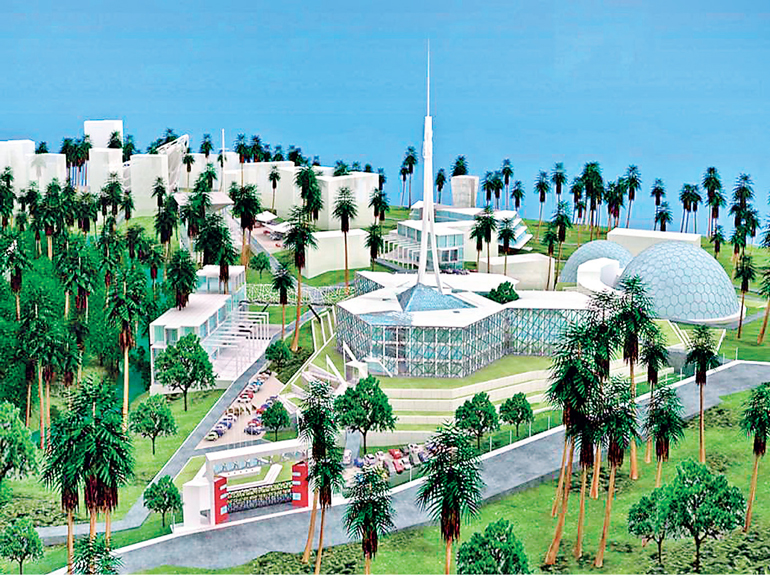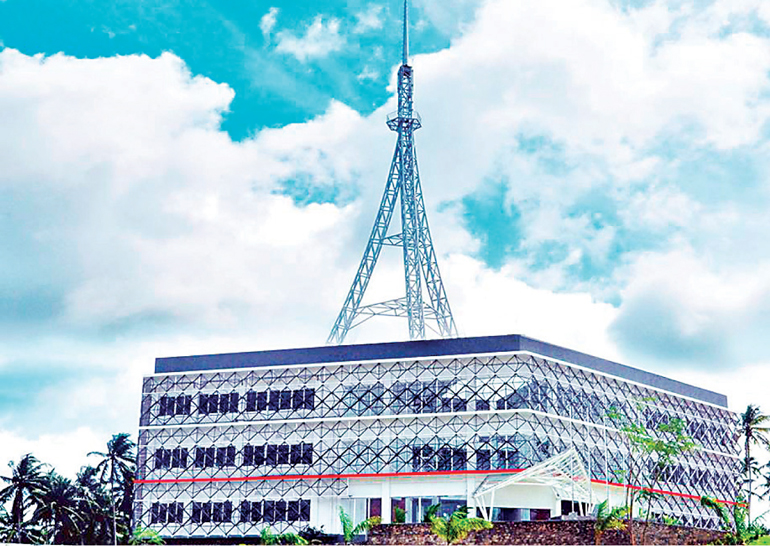Monday Apr 28, 2025
Monday Apr 28, 2025
Thursday, 8 October 2015 00:00 - - {{hitsCtrl.values.hits}}
 SLINTEC model
SLINTEC model
Recently a statement was made by the Deputy Foreign Minister at a function as the way forward for Sri Lanka – export, export, and export! It is indeed a strong prompt, yet easier said than done. To achieve this situation, bold and aggressive interventions need to happen across multiple fronts. 
Exporting more coconuts, gems or tea or more of the same is not going to make waves and the earlier this is understood, the simpler the task ahead would be. When one observes our export structure over the years, except for the emergence of textiles and IT products, one may not see a radical structural difference over the years. We may have put little bit more gloss over the way we do things but the export repertoire has hardly changed. Jam and cordials still are very much in vogue in some sectoral discussions.
Compared with any other country, this is a seriously poor picture when presented across the years since independence. What is not encouraging is, we still are engaged in discussing the same sectors with the fervent hope of getting some more by sending out a little bit more!
Negative mindset
We have really being behaving with a negative mindset as far as new frontiers go. We appear not to have much conviction over the concept of ‘Made in Sri Lanka’ with emerging technologies. Being laggards in these areas while boasting of high literacy is a serious indictment of our way of thinking and execution.
For a start there is the need to start believing in ourselves and throw away the mediocre mindset that tends to be carried on to the decision making stage. Being bold is not always respecting the traditional fare of ratios and analysis. One need not be a genius to understand if one starts calculating typical financial investment ratios for a new technology project the answer is always going to come out in a negative way. You only have to be surprised if the answers come out in any other way.
If one has some money if the decision is to invest in a hotel (if preferably with a casino included) or a hospital, a tropical fruit-based essence facility, or an investment on an enzyme facility, the answer always likely to be a hotel or a hospital. The former is neatly supported by the year-on-year growth in tourism. The latter is also perhaps easily justified by the year-on-year growth of patients as well those who take on insurance. What really may matter in changing the landscape is by high technology manufacturing or a high technology service facility which definitely require some extra courage. Boardroom decisions at this juncture demonstrate amply the former.
This was once indirectly stated by a former Japanese Ambassador to Sri Lanka. He stated that we have an economy where banks come in top tier of most valued institutions and this should not be so. All our banks interestingly appear to be the best in Sri Lanka which each one convincingly displaying their awards. How this can happen is certainly as a layman in banking I can only hazard to guess.
Being bold
Being bold is also taking on a challenge which almost likely to change the trajectory of a nation. Perhaps President JFK’s quest to conquer the moon was one; 24 billion dollars was the investment made by USA in getting a man to the moon and back – the Apollo program. Of course the initial estimate had been $ 7 billion but nobody ever asked for an explanation for this flow in estimate but the glory of conquest on nation’s psyche was what mattered.
The US Apollo program has been named by some to be the greatest technological achievement in human history. Well it was achieving what in 1961 was perhaps a mission impossible! As to be expected, Apollo contributed to the growth of US industry. Technologies developed to conquer space became hits terrestrially. Computer-controlled machinery was an innovation and so were battery-powered tools. Fundamental research towards integrated circuits took place as module units and command mechanisms evolved.
The responsibility of sending and receiving men back was always there and meticulous planning and design was essential. As this was a journey into the unknown, advances in sciences and technologies were central to the achievement. This is the strategic benefit of a bold venture. Once successful there is always going to be a huge multiplier effect.
If you teach information technology and spend all your energy to achieve a data centre, the net outcome would be little bit more personal income than the usual. Remember why you are requested to attend to a data centre is because it is not worth being invested on in a developed country because those developments are not newsworthy in terms of growth. Such enterprises are simply farmed out for innovation laggards to execute.
National innovation eco system
Do we have an opportunity to bring about an ‘Apollo effect’? As we still differ from the equivalent of US in 1961, one area we have to be creative is in establishing a national innovation eco system. Where should one place the epicentre? One place comes to my mind. The Nanoscience Park at Homagama. While as an outsider one does not hear much news from Sri Lanka’s bold venture into nanotechnology, I presume there is much going on inside. However, I remember the initial design drawing where the symbolic three hexagons and the tower were shown majestically inside a land mass which was to be the iconic park.
Today at Homagama the design has been realised to a certain degree. One hexagon proudly stands housing the Nanotechnology Research and Development Wing and boasts of having certainly the most advanced as well as varied high-end equipment present in Sri Lanka under one roof. The place is unique too with a Certified Platinum Rating in terms of Green Building Concept. Surley one could be proud of this and the country has all the rights for expecting some advances that may help our economy to truly differentiate.
This situation may be similar to Singapore’s Biopolis though much limited in scale. Both the current hexagon at Homagama and the Biopolis in Singapore boast of supporting one emerging technology area. While nanotechnology is to Homagama, biotechnology has been for the Biopolis. Singapore has moved on with Fusionpolis now by creating a whole new world of space, enabling convergence of technologies to one place.
Triple convergence
Three technologies transforming the world are nanotechnology, biotechnology and information technology. Convergence of these three potentially-disruptive technologies coming together, the synergy would be tremendous. The role for information technology is via high-end computing, grid computing, simulation and modelling with super-computing facilities. As an example, the combination of biotechnology and information technology has led to the world of bioinformatics. This convergence along with nanotechnology may pave the way for personalised medicine and personalised nutrition.
These are exciting areas, the virgin territories to explore and conquer. Where our literacy and the imagination should be prompted to venture into, explore, conquer and deliver. Investments in these areas necessarily do carry high risks but so is the nature of rewards upon conversion. Our rewards via the conventional investments are still not much to boast about. As with a hotel, a complete season may be wasted if a volcano is to erupt in some faraway place as once happened. The type of investments that we have engaged in have poor multiplier potentials and as such offer poor prospects to the economy.
 SLINTEC, Homagama
SLINTEC, Homagama
Be bold again
It must be remembered though the triple convergence was stressed the strongest, today have embraced another technology for convergence in addition to the above-listed three. The newcomer is the cognitive science where the desired benefit is a wholly-new human experience. While acknowledging that the world is looking at and has moved beyond triple convergence, the choice for Sri Lanka considering that we have worked within a single silo up to now is to embrace at least the triple convergence.
The way forward perhaps is first to be bold again at Homagama. Raise the two remaining hexagons from bottom up with each being dedicated to biotechnology and information technology. Hope the nature of IT has been made clear. Bring high end in-silico (simulations within silicon chips) into practice with high end computing and data support structure and thereby giving speed to NT and BT areas housed within the other two hexagons.
This carried out as a PPT venture within a defined timeframe is sure to transform the innovation landscape of Sri Lanka. One dice had already being thrown and that was a significant bold and an enterprising step – perhaps the most difficult step. It did happen though the country in my view has not really capitalised on it.
Kennedy’s venture with Apollo had the slogan of ‘Let’s Get This Country Moving Again’. Ours may have to be a trifle different as we never really said nor stated our growth intentions via exploring the scientific frontiers. The coward within us always did succeed in sending the wrong message. Help, subsidies, grants and soft loans have been some words we have quite eloquently used, but if the future is going to be different there is the need for the change in vocabulary along with an emboldened mindset.
[The writer is Professor of Chemical and Process Engineering at the University of Moratuwa, Sri Lanka. With an initial BSc Chemical engineering Honours degree from Moratuwa, he proceeded to the University of Cambridge for his PhD. He is the Project Director of COSTI (Coordinating Secretariat for Science, Technology and Innovation), which is a newly established State entity with the mandate of coordinating and monitoring scientific affairs. He can be reached via email on [email protected].]
Discover Kapruka, the leading online shopping platform in Sri Lanka, where you can conveniently send Gifts and Flowers to your loved ones for any event including Valentine ’s Day. Explore a wide range of popular Shopping Categories on Kapruka, including Toys, Groceries, Electronics, Birthday Cakes, Fruits, Chocolates, Flower Bouquets, Clothing, Watches, Lingerie, Gift Sets and Jewellery. Also if you’re interested in selling with Kapruka, Partner Central by Kapruka is the best solution to start with. Moreover, through Kapruka Global Shop, you can also enjoy the convenience of purchasing products from renowned platforms like Amazon and eBay and have them delivered to Sri Lanka.
Discover Kapruka, the leading online shopping platform in Sri Lanka, where you can conveniently send Gifts and Flowers to your loved ones for any event including Valentine ’s Day. Explore a wide range of popular Shopping Categories on Kapruka, including Toys, Groceries, Electronics, Birthday Cakes, Fruits, Chocolates, Flower Bouquets, Clothing, Watches, Lingerie, Gift Sets and Jewellery. Also if you’re interested in selling with Kapruka, Partner Central by Kapruka is the best solution to start with. Moreover, through Kapruka Global Shop, you can also enjoy the convenience of purchasing products from renowned platforms like Amazon and eBay and have them delivered to Sri Lanka.